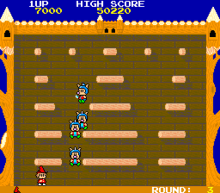The Fairyland Story
| The Fairyland Story | |
|---|---|
| Developer(s) | Taito |
| Publisher(s) | Taito |
| Platform(s) | Arcade, MSX, X68000, Mobile Phone |
| Release date(s) | Arcade
|
| Genre(s) | Platformer |
| Mode(s) | Up to 2 players alternating |
| Cabinet | Upright |
| Display | Raster, standard resolution |
The Fairyland Story (フェアリーランドストーリー Fearīrandosutōrī) is a arcade platform video game released by Taito in July 1985.[1] The game was ported to the MSX and X68000 computers, and it later appeared on Taito Memories (Japan) and Taito Legends 2 (World) for the PS2 while the latter also on the Xbox and the PC.
The game itself was not a great success compared to more famous Taito games such as Bubble Bobble or Rainbow Islands, but it can be considered one of the ancestors in the popular Bubble Bobble series of video games. Many of Bubble Bobble's gameplay elements, and even some graphics and bonuses, first appeared in The Fairyland Story. The game's protagonist, Ptolemy, also appears as a bonus in Bubble Symphony.
Gameplay
In the game, the player guides the little witch Ptolemy through a series of single-screen levels, the goal being to eliminate all enemies and proceed to the next level. Ptolemy's main weapon is her magic attack, which can turn enemies into cakes for a short while.[2] While in a "caked" form, the enemies can be either be destroyed by further magic attacks or by being dropped off a platform, possibly squashing other enemies below. Squashing more than one enemy results in an award of more points and, sometimes, in extra bonuses. 2000 points are awarded for squashing an enemy below a cake, with each additional enemy doubling the amount of points awarded. If three or more enemies are killed at once in one spot, bonus coins appear in that spot which may be collected for additional points.

Ptolemy's enemies include typical fantasy beings like orcs, mages, ogres, and dragons. There is also a doppelgänger Pope or Cardinal-like enemy. There are also "Stoners" (called "Mightas" in Japan) from the earlier Taito arcade Chack'n Pop, although they appear in dark-colored robes as opposed to the white robes they wore in Chack'n Pop. Orcs have a pig-like appearance resembling the orcs depicted in the original Advanced Dungeons & Dragons manuals. Mages cast spells that turn Ptolemy into a shrunken figure that disappears into her hat, with a second dose causing death. Dragons breathe fire. Mighta Wizards may phase out causing them to be temporarily immune to Ptolemy's spells. The doppelgänger creates several copies of itself. Ogres remain in "cake" form for a shorter period of time than other enemies and require more spell-casts to kill.
If Ptolemy takes too long to clear a level of a last remaining enemy, eventually that enemy will disappear without an award of points. If, however, Ptolemy takes too long to clear more than one enemy from the level, a flying Devil appears that can kill Ptolemy by touching her, and it begins to follow her slowly. The devil is invulnerable to attack. After it appears the only way to survive is for Ptolemy to kill all remaining enemies. This game element is very similar to the "Beluga" or "Skel Monsta" fish that limit the time allowed for each level in the later Taito game "Bubble Bobble."
Ptolemy's deaths are animated in different ways. Contact with an enemy causes Ptolemy's death, which is depicted by Ptolemy floating away in a bubble. A second mage's spell causes Ptolemy to disappear. A dragon's breath causes her to burn to a cinder.
Ptolemy can sometimes collect some utility bonuses which increase her speed or the power and range of her magic for a short while, or offensive bonuses that, most usually, result in the cake-ification and destruction of all on-screen enemies.
At various intervals between levels, an intermission screen appears during the game showing Ptolemy riding on the back of a large, flying green dragon. A message appears on each of these intermission screens, either congratulating the player or warning of some hazard in the next level. Many of these messages contain incorrect English idioms or grammar typical of Engrish.
Other Appearances
Playables
- Space Invaders DX (1994):
- Pop'n Pop (1998):
- Daifugo Party (2010):
Cameo appearances in other games
- Bubble Bobble (1986): Several of the magical bonuses that appear in Bubble Bobble either are adaptations of, or are directly taken from The Fairyland Story. Ptolemy herself also appears as a bonus in the game. Dark-robed Stoners/Mightas appear as enemies in both Bubble Bobble and The Fairyland Story.
- Rainbow Islands (1987): Magical Island, an unlockable eighth island, has enemies and other features drawn directly from The Fairyland Story.
- Bubble Symphony (1994):
- Bubble Memories (1996):
- Arkanoid DS (2007): Ptolemy appears as the breakable block design of stage Beta-5.
References to Chack'n Pop
The Taito game designers incorporated several elements from the earlier Taito game, Chack'n Pop. The Stoner/Mighta wizards from Chack'n Pop appear as ghost-like phasing enemies in The Fairyland Story. In addition, Level 37 of The Fairyland Story has an arrangement of platforms that are designed to appear like the Mr. Chack'n character from Chack'n Pop.
References
- ↑ "The Fairyland Story". The International Arcade Museum. Retrieved 10 Nov 2013.
- ↑ "The Fairyland Story". MobyGames. Retrieved 10 Nov 2013.
External links
| ||||||||||||||||||